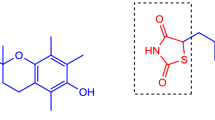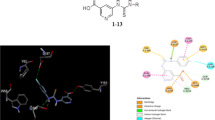Abstract
The present work describes an efficient and convenient synthesis of a library of novel 3-(substituted benzoyl)-2-thioxoimidazolidin-4-ones (3a–j). The benzoyl isothiocyanates were treated with glycine in the presence of pyridine, the reactants got consumed giving a variety of thioxoimidazolidin-4-ones derivatives under mild reaction conditions. The structures of the compounds were determined by elemental analysis, FTIR, 1H, 13C NMR and mass spectral data. The title compounds were tested for their potential to inhibit the activity of enzymes α-glucosidase and α-amylase. It was found that most of the derivatives showed good enzyme inhibitory activity while compound 3j exhibited excellent activity with IC50 values 0.051 and 0.0082 mM for α-glucosidase and α-amylase, respectively. The presence of 3,5-di-NO2 functional groups at aromatic ring in compound 3j play important role in enzyme inhibitory activity. The enzyme inhibitory kinetic analysis of the most potent derivative 3j revealed that it is a mixed type inhibitor of α-glucosidase with Ki and Kiʹ values 0.0339 and 0.1562 mM, respectively. It was further investigated that compound 3j formed reversible enzyme inhibitor complex with α-glucosidase. The cytotoxicity of all the synthesized compounds was also evaluated and results showed that none of these compounds displayed toxicity against brine shrimps. Based upon results, it is suggested that compound 3j may act as a lead structure for the development of most potent α-glucosidase inhibitors.



Similar content being viewed by others
References
Ashraf Z, Rafiq M, Seo S-Y, Babar MM, Zaidi N-u-SS (2015) Design, synthesis and bioevaluation of novel umbelliferone analogues as potential mushroom tyrosinase inhibitors. J Enzym Inhib Med Chem 30:874–883
Bae YS, Choi S, Park JJ, Joo JH, Cui M, Cho H, Lee WJ, Lee SH (2016) Synthesis and biological evaluation of 3-substituted 5-benzylidene-1-methyl-2-thiohydantoins as potent NADPH oxidase (NOX) inhibitors. Bioorg Med Chem 24:4144–4151
Baell JB, Holloway GA (2010) New substructure filters for removal of pan assay interference compounds (PAINS) from screening libraries and for their exclusion in bioassays. J Med Chem 53:2719–2740
Bhandari MR, Jong-Anurakkun N, Hong G, Kawabata J (2008) α-Glucosidase and α-amylase inhibitory activities of Nepalese medicinal herb Pakhanbhed (Bergenia ciliata, Haw.). Food Chem 106:247–252
Carmi C, Cavazzoni A, Zuliani V, Lodola A, Bordi F, Plazzi PV, Alfieri RR, Petronini PG, Mor M (2006) 5-Benzylidene-hydantoins as new EGFR inhibitors with antiproliferative activity. Bioorg Med Chem Lett 16:4021–4025
Chakrabarti R, Rajagopalan R (2002) Diabetes and insulin resistance associated disorders: disease and the therapy. Curr Sci (Bangalore) 83:1533–1538
DeFronzo RA, Mandarino L, Ferrannini E (2004) Metabolic and molecular pathogenesis of type 2 diabetes mellitus. International textbook of diabetes mellitus, Vol. 1. John Wiley, UK
Kachhadia V, Patel M, Joshi H (2005) Heterocyclic systems containing S/N regioselective nucleophilic competition: facile synthesis, antitubercular and antimicrobial activity of thiohydantoins and iminothiazolidinones containing the benzo[b]thiophene moiety. J Serb Chem Soc 70:153–161
Kameswararao B, Kesavulu M, Apparao C (2003) Evaluation of antidiabetic effect of Momordica cymbalaria fruit in alloxan-diabetic rats. Fitoterapia 74:7–13
Khatik GL, Kaur J, Kumar V, Tikoo K, Venugopalan P, Nair VA (2011) Aldol derivatives of thioxoimidazolidinones as potential anti-prostate cancer agents. Eur J Med Chem 46:3291–3301
Loh SP, Hadira O (2011) In vitro inhibitory potential of selected Malaysian plants against key enzymes involved in hyperglycemia and hypertension. Malays J Nutr 17:77–86
Matsui T, Tanaka T, Tamura S, Toshima A, Tamaya K, Miyata Y, Tanaka K, Matsumoto K (2010) α-Glucosidase inhibitory profile of catechins and theaflavins. J Agric Food Chem 55:99–105
Mendgen T, Steuer C, Klein CD (2012) Privileged scaffolds or promiscuous binders: a comparative study on rhodanines and related heterocycles in medicinal chemistry. J Med Chem 55:743–753
Muccioli GG, Martin D, Scriba GK, Poppitz W, Poupaert JH, Wouters J, Lambert DM (2005) Substituted 5, 5’-diphenyl-2-thioxoimidazolidin-4-one as CB1 cannabinoid receptor ligands: synthesis and pharmacological evaluation. J Med Chem 48:2509–2517
Pires DEV, Blundell TL, Ascher DB (2015) pkCSM: predicting small-molecule pharmacokinetic properties using graph-based signatures. J Med Chem 58:4066–4072
Puszyńska-Tuszkanow M, Grabowski T, Daszkiewicz M, Wietrzyk J, Filip B, Maciejewska G, Cieślak-Golonka M (2011) Silver (I) complexes with hydantoins and allantoin: synthesis, crystal and molecular structure, cytotoxicity and pharmacokinetics. J Inorg Biochem 105:17–22
Salhi L, Bouzroura A, Benmalek Y, Bentarzi Y, Martini P, Cacciuttolo B, Dunach E, Kolli N (2013) An efficient conversion of maleimide derivatives to 2-thioxo imidazolidinones. Org Commun 6:87–94
Takahashi A, Matsuoka H, Yamada K, Uda Y (2005) Characterization of antimutagenic mechanism of 3-allyl-5-substituted 2-thiohydantoins against 2-amino-3-methylimidazo[4,5-f]quinoline. Food Chem Toxicol 43:521–528
Vengurlekar S, Sharma R, Trivedi P (2012) A study on the biological activity of 2-thioxo-imidazolidin-4-ones. Lett Drug Des Discov 9:549–555
Watanabe J, Kawabata J, Kurihara H, Niki R (1997) Isolation and identification of α-glucosidase inhibitors from tochu-cha (Eucommia ulmoides). Biosci Biotechnol Biochem 61:177–178
World Health Organization (2002) WHO traditional medicine strategy 2002–2005. WHO Publications. 1–6
Author information
Authors and Affiliations
Corresponding authors
Ethics declarations
Conflict of interest
The authors declare that they have no conflict of interest.
Rights and permissions
About this article
Cite this article
Qamar, R., Saeed, A., Saeed, M. et al. Synthesis and enzyme inhibitory kinetics of some novel 3-(substituted benzoyl)-2-thioxoimidazolidin-4-one derivatives as α-glucosidase/α-amylase inhibitors. Med Chem Res 27, 1528–1537 (2018). https://doi.org/10.1007/s00044-018-2170-4
Received:
Accepted:
Published:
Issue Date:
DOI: https://doi.org/10.1007/s00044-018-2170-4




